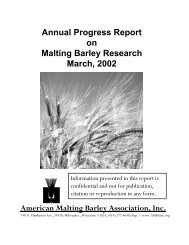Annual Progress Report on Malting Barley Research March, 2007
Annual Progress Report on Malting Barley Research March, 2007
Annual Progress Report on Malting Barley Research March, 2007
Create successful ePaper yourself
Turn your PDF publications into a flip-book with our unique Google optimized e-Paper software.
Net Blotch of <strong>Barley</strong>: Survey of Pathogen Virulence<br />
Timothy L. Friesen<br />
USDA-ARS<br />
Northern Crop Science Laboratory<br />
Cereal Crops <strong>Research</strong> Unit<br />
Fargo, ND 58105<br />
Executive Summary: Because net blotch <strong>on</strong> barley has the potential to cause<br />
severe yield loss as well as a reducti<strong>on</strong> in quality and that most barley lines are<br />
moderately to highly susceptible, it is important that we have an understanding of<br />
host resistance and pathogen virulence in this important host-pathogen system.<br />
This proposal was aimed at identifying pathogen virulence present in the<br />
Pyrenophora teres field populati<strong>on</strong>s at Langd<strong>on</strong> and Fargo, ND in 2004 and 2005 in<br />
an attempt to characterize the variability of virulence of P. teres the causal agent of<br />
net blotch <strong>on</strong> barley. Successful progress in this research will help our<br />
understanding of the virulence as it relates to specific resistance genes in the host<br />
with the ultimate goal of being able to effectively breed for durable net blotch<br />
resistance. Several good resistance sources have been identified that have not<br />
been overcome by any of the P. teres isolates collected to date. This research will<br />
be c<strong>on</strong>ducted each year to m<strong>on</strong>itor changes in the pathogen populati<strong>on</strong> in order to<br />
provide important informati<strong>on</strong> <strong>on</strong> the effectiveness of various sources of resistance.<br />
What major objectives or issues are being resolved short and l<strong>on</strong>g term, how are<br />
you resolving them, and what are the expected benefits?<br />
In the present study we have identified what resistance genes are effective in the<br />
field populati<strong>on</strong> and at the same time identifying which genes are ineffective in<br />
combating net blotch of barley in the ND/MN regi<strong>on</strong> in the previous two growing<br />
seas<strong>on</strong>s. We have also identified changes in virulence within the pathogen<br />
populati<strong>on</strong> over the two year period tested, showing that the pathogen populati<strong>on</strong><br />
has the ability to change if selecti<strong>on</strong> pressures such as the introducti<strong>on</strong> of single<br />
resistance genes were applied. L<strong>on</strong>g term, it is our objective to m<strong>on</strong>itor the change<br />
in the P. teres populati<strong>on</strong> to identify what resistance genes have been overcome or<br />
have the potential to be overcome. This m<strong>on</strong>itoring will aid in choosing resistance<br />
genes for developing durably resistant barley cultivars.<br />
What objectives were met and/or outputs produced in the <strong>on</strong>e-year funding period?<br />
Using a varied barley differential set with published differences we have identified<br />
which lines c<strong>on</strong>tain the most effective resistance. The most effective resistance<br />
sources in the year 2005 study are barley genotypes CI1179 (Algerian), CI5791,<br />
92
















